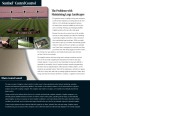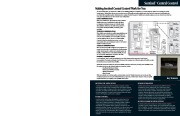From inside (document excerpt):
SENTINELTM CENTRAL CONTROL Central Control Sentinel SIMPLICITY Installing and setting up irrigation control over an entire system from a central computer is simple with Sentinel Central Control Software as 90% of all operations are executed in one screen. With a simple click, navigation to screens such as manual watering, rain shutdowns, hydraulic flow simulation graphs, and extensive troubleshooting and feedback from the satellites in the field can be accomplished.
Lawn Sprinkler User Manual Free Download. Irrigation Free Instruction Manual Download PDF.
All data in the system is stored at both the computer and the satellites so in the event of a power outage at the computer, the satellites will still irrigate according to their previous watering schedule. Engineered to the highest quality and reliability, yet simple to use, the Sentinel Central Control System is ideal for controlling multiple irrigation sites with diverse landscapes and multiple watering requirements. FLEXIBILITY The Sentinel Central Control System provides the utmost in flexibility for designers, contractors, and end users. Sentinel Field Satellites are built with modular station counts ranging from 12 to 48 stations which allow the end user to expand in 12 station increments without having to purchase a new controller. Also, the field satellites can be built in a variety of wall or pedestal-mounted enclosures in order to best meet various site applications needs. CONVENIENCE The Sentinel System is shipped from the factory with the ability to read and react to flow sensors. It is also handheld remote ready, which means the customer doesn’t have to purchase any add-ons for the Sentinel remote (SHHR) to function with the system. In addition, the system is compatible with a variety of weather-sensing devices such as Weather Stations and Rain Sensors which allow the user to control watering more precisely. SentinelTM Central Control The Problems with Maintaining Large Landscapes The global economy is rapidly evolving and companies, as well as their employees, are being asked to do more with less. In the landscape management business, this means fewer resources available to work on jobs such as mowing, trimming, and managing multiple irrigation systems which are often miles apart. Because there are only so many hours in the workday and only so many employees per staff, the scheduling of automatic irrigation controllers is often overlooked when maintaining large landscapes. While you might have time to open up a controller and manually operate stations to make sure they are operable, you probably won’t have time to reprogram the controller each time you visit the site. After fixing clogged or broken nozzles, fine tuning rotor spray patterns, and troubleshooting valves and solenoids, no time is left for the controller. The irrigation business has been trying hard to educate contractors and end users on the necessity of applying the right amount of water to each type of plant material no more, and no less. Historically, this has been difficult or impossible to accomplish, since it required constant, manual reprogramming. Run times must be adjusted daily to reflect dynamic weather patterns, so this should be an automatic funtion. When left to maintenance contractors or agency staffs, this is rarely done and ends up wasting significant amounts of water, labor, energy and most of all money. But there is a solution .Irrigation Central Control. What is Central Control? The main concept of irrigation central control is to allow a user to have operational control, system monitoring, reporting functions and multi-level programming abilities in one location. In this instance, location is not so much defined as a physical location, but as a PC or laptop computer. The computer may remain in one place, or be mobile and continually moved from place to place. Unique central control software allows the user to construct and download complete, automatic, irrigation programs, or to manually operate satellite functions and valves.


 Toro Owners Manual - 1 of 4
Toro Owners Manual - 1 of 4 Toro Owners Manual - 2 of 4
Toro Owners Manual - 2 of 4 Toro Owners Manual - 3 of 4
Toro Owners Manual - 3 of 4 Toro Owners Manual - 4 of 4
Toro Owners Manual - 4 of 4